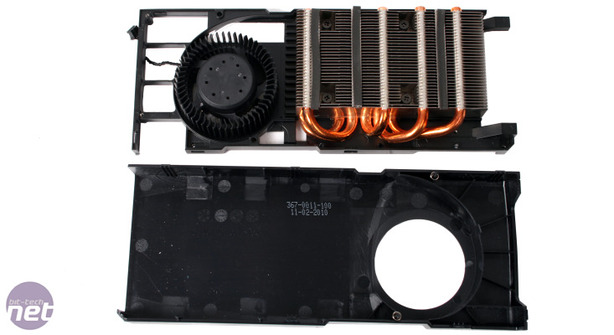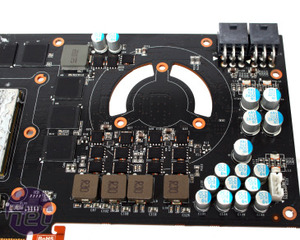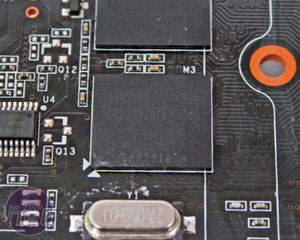
Cooling
The GeForce GTX 470 uses a standard radial fan and heatsink cooling layout, with a vent that occupies the whole width of the card. There’s no venting along the length of the card, although some air does spill out of the area around the SLI connectors, so the fan should have plenty of pressure to push hot air out the back.Like the GeForce GTX 480, the GTX 470 has a two-part cooler that allows you to unclip the top half to clean out the fan and heatsink, although you still have to unscrew the four large screws around the rear of the GPU. This makes it easier to fit a waterblock too, as the modular nature of the cooler is easier to grapple with than some all-in-one designs. The heatsink, while smaller than that of the GTX 480, still uses five direct-contact heatpipes to suck heat from the GPU into the cooling fins.
PCB
The secondary part of the cooler acts as a heatsink for the memory and elements of the VRM circuitry. It can be detached via the four smaller screws around the GPU and the two screws in the output plate. Once the second portion of the cooler is removed you can see the PCB, which has a very distinctive appearance.There’s a large hole for the fan to suck air in through the PCB as well as the fan’s top, which could help airflow when using SLI. If you’ve followed Nvidia closely, you’ll also know that these kinds of PCBs are regularly used where heat could be a potential problem – most dual-GPU GeForce cards have a similar hole in the PCB.
The hole leads to an odd power circuit layout, with the four-phase power for the GPU squashed into one corner of the PCB along with a bunch of capacitors that sit between the two 6-pin power connectors and the power phases themselves. On the other side of fan hole is the single-phase power delivery for the memory. As with the GTX 480, there’s no digital power switching (something that you will see on HD 5000-series cards).
Around the GPU you can see the ten Samsung K4G10325FE 128MB GDDR5 chips, making up the 1,280MB of memory. As this is a different PCB to that of the GTX 480 (it’s shorter, doesn’t have room for an 8-pin PCI-E power connector to be added and had different VRM circuitry) there’s no gap where an eleventh memory module would be on the GTX 480 card.

MSI MPG Velox 100R Chassis Review
October 14 2021 | 15:04












Want to comment? Please log in.